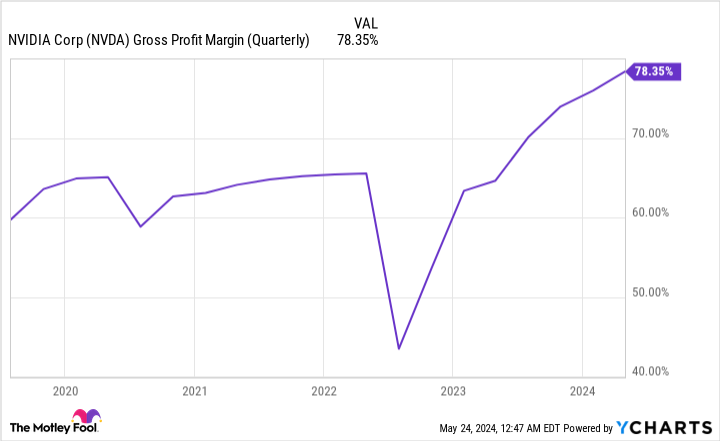Despite no shortage of next-big-thing investment trends over the last three decades, nothing has come close to capturing the buzz that was created on Wall Street when the internet transformed corporate America in the mid-1990s. That is, until now.
For more than a year, professional and retail investors have been captivated by the game-changing potential of artificial intelligence (AI). AI involves using software and systems in place of humans, and allowing these systems to learn and evolve over time without human intervention. Ideally, AI can become more proficient at repetitive tasks, and possibly even learn new skills over time, which would give the technology utility in pretty much every sector and industry.

As is to be expected, estimates of what AI can bring to the table are all over the place. The standout prognostication comes from the analysts at PwC who believe AI can add $15.7 trillion to the global economy by the turn of the decade.
Although dozens of companies are benefiting from the artificial intelligence revolution, none has more directly seen its share price and operating performance ascend to the heavens quite like semiconductor titan Nvidia (NASDAQ: NVDA).
Nvidia, once again, blew past even the loftiest expectations
One week ago, Nvidia lifted the hood on its fiscal first-quarter operating results (Nvidia’s fiscal year ends in late January) and did what it’s been doing with consistency for more than a year — it blew past any and all expectations from Wall Street institutions and analysts.
Net sales for the company surged a cool 262% to $26 billion from the prior-year period, with its Data Center operations leading the charge. Data Center sales catapulted by 427% on a year-over-year basis to $22.6 billion, with the company’s A100 and H100 graphics processing units (GPUs) leading the charge.
In particular, Nvidia’s H100 GPUs are the undeniable top choice by the world’s leading businesses for their AI-accelerated data centers. The H100 is being used to train large language models (LLMs) and power generative AI solutions on cloud infrastructure service platforms. Nvidia controls as much as 90% of the AI-accelerated GPU market.
With demand handily outpacing supply, Nvidia is enjoying exceptionally strong pricing power for its chips. Whereas the company’s cost of revenue (across all segments) rose by 122% from the prior-year period, net sales increased by more than twice this rate (the noted 262%) in the fiscal first quarter.
Nvidia’s top line is also going to benefit from supply chain kinks beginning to work themselves out. Taiwan Semiconductor Manufacturing has been meaningfully increasing its chip-on-wafer-on-substrate capacity, which should allow Nvidia to meet more of its customers’ orders.
The icing on the cake is that the company also announced a 10-for-1 stock split and increased its token quarterly dividend by 150%.
In the 24 hours following Nvidia’s earnings release, more than a half-dozen investing sites and Wall Street organizations referred to the company’s results as a “blowout” in the headlines. But what seemingly every investor appears to have missed is the subtle warning Nvidia provided with its fiscal second-quarter guidance during its conference call.


Nvidia’s guidance contains a red flag that shouldn’t be ignored
For the current quarter, Nvidia expects sales of $28 billion, plus or minus 2%, which easily sailed past the consensus for analysts of about $26.66 billion. While noting demand is overwhelming supply, Nvidia also forecast gross margin of 75.5%, plus or minus 50 basis points.
Superficially, this guidance looks great. After delivering a 64.6% gross margin in the fiscal first quarter of 2024, Nvidia’s forecast for a 75.5% gross profit margin in the current quarter appears to show just how quickly this nearly $2.6 trillion company has scaled. But there’s a very casual warning here that optimists may be blindly overlooking.
In the quarter ended on April 28, Nvidia’s gross margin came in at 78.35% ($20.406 billion in gross profit divided into $26.044 billion in revenue X 100). In the second quarter, the company’s gross margin is set to retrace by 235 to 335 basis points, based on Nvidia’s guidance. This might not sound like much, given that its gross margin has expanded by roughly 13.8 percentage points in a year, but it very likely marks the arrival of two awaited headwinds for the company.
First of all, Nvidia’s external competition is tangibly manifesting. After effectively having the high-compute GPU market to itself, Nvidia will be contending with the launch of Intel‘s (NASDAQ: INTC) Gaudi3 AI-accelerator during the third quarter, and the ongoing rollout of Advanced Micro Devices‘ (NASDAQ: AMD) MI300X GPU. Both companies have their sights squarely set on rivaling Nvidia’s H100 GPUs and winning over enterprises wanting to train LLMs and operating generative AI solutions.
Even if Nvidia’s AI-GPUs remain superior to AMD’s and Intel’s AI-accelerator chips in speed and compute capability, the mere fact that this data center hardware is hitting the market will reduce the scarcity of AI-GPU chips. This scarcity has been the fuel propelling the price of Nvidia’s GPUs into the stratosphere. A sequential 235-basis-point to 335-basis-point decline in gross margin might be a signal that weaker pricing power is on the horizon.
The other issue for Nvidia that shouldn’t be ignored is that its top customers are all developing their own AI-GPUs.
Microsoft, Meta Platforms, Amazon, and Alphabet account for about 40% of Nvidia’s net sales. Meta Platforms even upped its capital expenditures forecast for 2024, likely to bolster its investments in Nvidia’s AI-GPUs. But with all four actively building and deploying in-house AI-accelerators for their data centers, their reliance on Nvidia’s hardware is almost certain to diminish in the quarters and years to come. This might be somewhat reflected in Nvidia’s forecast sequential decline in gross margin.
I’d be remiss if I didn’t also note that every next-big-thing innovation or trend for three decades has endured a bubble-bursting event. While Nvidia looks untouchable at the moment, history is undefeated when it comes to the early stage ramp of buzzy innovations and technologies.
Nvidia’s fiscal second-quarter gross margin guidance may well signal that Nvidia’s stock has peaked.
Should you invest $1,000 in Nvidia right now?
Before you buy stock in Nvidia, consider this:
The Motley Fool Stock Advisor analyst team just identified what they believe are the 10 best stocks for investors to buy now… and Nvidia wasn’t one of them. The 10 stocks that made the cut could produce monster returns in the coming years.
Consider when Nvidia made this list on April 15, 2005… if you invested $1,000 at the time of our recommendation, you’d have $652,342!*
Stock Advisor provides investors with an easy-to-follow blueprint for success, including guidance on building a portfolio, regular updates from analysts, and two new stock picks each month. The Stock Advisor service has more than quadrupled the return of S&P 500 since 2002*.
*Stock Advisor returns as of May 28, 2024
John Mackey, former CEO of Whole Foods Market, an Amazon subsidiary, is a member of The Motley Fool’s board of directors. Randi Zuckerberg, a former director of market development and spokeswoman for Facebook and sister to Meta Platforms CEO Mark Zuckerberg, is a member of The Motley Fool’s board of directors. Suzanne Frey, an executive at Alphabet, is a member of The Motley Fool’s board of directors. Sean Williams has positions in Alphabet, Amazon, Intel, and Meta Platforms. The Motley Fool has positions in and recommends Advanced Micro Devices, Alphabet, Amazon, Meta Platforms, Microsoft, Nvidia, and Taiwan Semiconductor Manufacturing. The Motley Fool recommends Intel and recommends the following options: long January 2025 $45 calls on Intel, long January 2026 $395 calls on Microsoft, short January 2026 $405 calls on Microsoft, and short May 2024 $47 calls on Intel. The Motley Fool has a disclosure policy.
Nvidia’s “Blowout” Quarter Contained a Subtle Warning That Most Investors Likely Missed was originally published by The Motley Fool

Jessica Roberts is a seasoned business writer who deciphers the intricacies of the corporate world. With a focus on finance and entrepreneurship, she provides readers with valuable insights into market trends, startup innovations, and economic developments.







